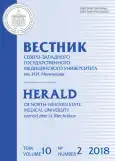Endothelial dysfunction and circulating endothelial cells in patients with chronic ischemic heart disease
- Authors: Sayganov S.A.1, Kuzmina-Krutetskaya A.M.1
-
Affiliations:
- North-Western State Medical University named I.I. Mechnikov
- Issue: Vol 10, No 2 (2018)
- Pages: 27-32
- Section: Articles
- URL: https://journals.rcsi.science/vszgmu/article/view/9276
- DOI: https://doi.org/10.17816/mechnikov201810227-32
- ID: 9276
Cite item
Full Text
Abstract
Aim. To evaluate endothelial function in patients with chronic ischemic heart disease by determining the number of circulating endothelial cells in peripheral blood.
Material and methods. 71 patient with typical angina class I–III and presence of obstructive coronary artery disease according to coronary angiography were assessed, coronary anatomy was assessed on the SYNTAX Score scale and the number of CEC was determined by flow cytofluorimetry. Depending on the chosen treatment strategy patients were divided into the following groups: a group of medical therapy (group 1) — 22 patients; a group of patients requiring percutaneous coronary intervention (group 2) — 25 patients; a group of patients requiring surgical revascularization by coronary artery bypass surgery (group 3) — 24 patients. The control group consisted of 20 patients without atherosclerotic lesions of the coronary arteries.
Results. Study groups do not differ by sex, age, history of smoking, the presence of hypertension, MI history (р > 0.05). In the group of patients who are scheduled to perform CABG significantly more patients with diabetes mellitus (р < 0.05) (group 1 — 3 patients (13.6%), group 2 — 4 patients (16.0%), group 3 — 7 patients (29.1%), control group — 2 patients (11.8%)). Study groups reliably differ in the anatomy of coronary lesions (SYNTAX Score in group 1 — 9.4 ± 2.7, in group 2 — 19.7 ± 5.7, in group 3 — 23.5 ± 6.0), р < 0.05. The number of CECs in the study groups is significantly higher than the generally accepted norm (р < 0.05), (group 1 — 12 (10÷16), group 2 — 14 (10÷17), group 3 — 14 (11÷17), control group — 12 (10÷16)). There are no significant differences between the groups with coronary artery disease (р > 0.05).
Conclusion. Study of endothelial function by flow cytometry using monoclonal fluorescently labeled antibodies to CD146 and CD45 can be considered as a criterion for noninvasive assessment of the severity of atherosclerotic lesion of the coronary bed.
Full Text
##article.viewOnOriginalSite##About the authors
S. A. Sayganov
North-Western State Medical University named I.I. Mechnikov
Author for correspondence.
Email: akrutetskaya@gmail.com
Russian Federation, Saint Petersburg
A. M. Kuzmina-Krutetskaya
North-Western State Medical University named I.I. Mechnikov
Email: akrutetskaya@gmail.com
Russian Federation, Saint Petersburg
References
- Halcox JP, Schenke WH, Zalos G, et al. Prognostic value of coronary vascular endothelial dysfunction. Circulation. 2002;106(6):653-658.
- Heitzer T, Schlinzig T, Krohn K, et al. Endothelial dysfunction, oxidative stress, and risk of cardiovascular events in patients with coronary artery disease. Circulation. 2001;104(22):2673-2678. doi: 10.1161/hc4601.099485.
- Matsuzawa Y, Lerman A. Endothelial dysfunction and coronary artery disease: Assessment, prognosis, and treatment. Coron Artery Dis. 2014;25:713-724. doi: 10.1097/MCA.0000000000000178.
- Matsuzawa Y, Guddeti RR, Kwon TG, et al. Secondary prevention strategy of cardiovascular disease using endothelial function testing. Circulation J. 2015;79(4):685-694. doi: 10.1253/circj.CJ-15-0068.
- Blann AD, Woywodt A, Bertolini F, et al. Circulating endothelial cells. Thromb Haemost. 2005;93:228-235.
- Erdbruegger U, Haubitz M, Woywodt A. Circulating endothelial cells: a novel marker of endothelial damage. Clinica Chimica Acta. 2006;373(1):17-26.
- Ong AT, Serruys PW, Mohr FW, et al. The SYNergy between percutaneous coronary intervention with TAXus and cardiac surgery (SYNTAX) study: design, rationale, and run-in phase. Am Heart J. 2006;151(6):1194-1204. doi: 10.1016/j.ahj.2005.07.017.
- Authors/Task Force members, Kolh P, Windecker S, Alfonso F, et al. 2014 ESC/EACTS guidelines on myocardial revascularization: The Task Force on Myocardial Revascularization of the European Society of Cardiology (ESC) and the European Association for Cardio-Thoracic Surgery (EACTS) developed with the special contribution of the European Association of Percutaneous Cardiovascular Interventions (EAPCI). Eur Heart J. 2014;46(4):517-592. doi: 10.1093/eurheartj/ehu278
- Феоктистова В.С., Вавилова Т.В., Сироткина О.В., и др. Новый подход к оценке дисфункции эндотелия: определение количества циркулирующих эндотелиальных клеток методом проточной цитометрии // Клиническая лабораторная диагностика. - 2015. - Т. 60. - № 4. [Feoktistova VS, Vavilova TV, Sirotkina OV, et al. The new approach to evaluation of endothelium dysfunction: detection of number of circulating endothelium cells using flow cytometry technique. Klinicheskaja Laboratornaja Diagnostika. 2015;60(4). (In Russ.)]
- Montalescot G, Sechtem U, Achenbach S, et al. Рекомендации по лечению стабильной ишемической болезни сердца. ESC 2013 // Российский кардиологический журнал. - 2015. - № 7. - С. 7-79. [Montalescot G, Sechtem U, Achenbach S, et al. 2013 ESC Guidelines on the management of stable coronary artery disease. Russian Journal of Cardiology. 2014;(7):7-79. (In Russ.)]. doi: 10.15829/1560-4071-2014-7-7-79.
- Emerging Risk Factors Collaboration. Diabetes mellitus, fasting blood glucose concentration, and risk of vascular disease: a collaborative meta-analysis of 102 prospective studies. The Lancet. 2010;375(9733):2215-2222.
- Widemann A, Sabatier F, Arnaud L, et al. CD146-based immunomagnetic enrichment followed by multiparameter flow cytometry: a new approach to counting circulating endothelial cells. J Thromb Haemost. 2008;6(5):869-876. doi: 10.1111/j.1538-7836.2008.02931.x.
- Shantsila E, Blann AD, Lip GYH. Circulating endothelial cells: from bench to clinical practice. J Thromb Haemost. 2008;6(5):865-868. doi: 10.1111/j.1538-7836.2008.02918.x.
Supplementary files







